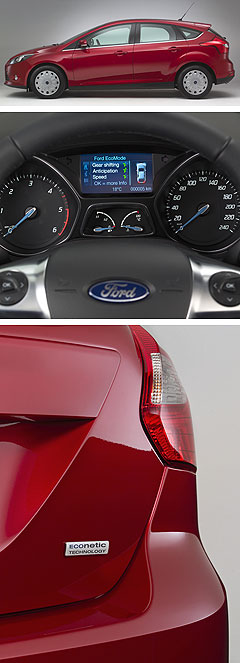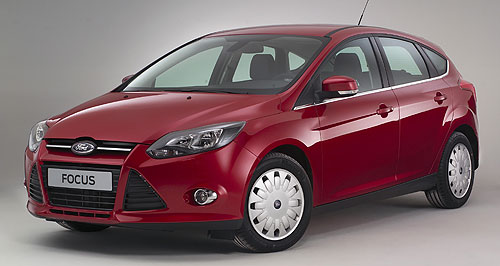Make / Model Search
Future models - Ford - Focus - EconeticFord reveals 3.5L/100km FocusFrugal: Econetic version of Ford's new Focus could join its super-thrifty Fiesta sibling in Australia. Ford’s new Focus Econetic uses less fuel than a Prius, is under consideration for Oz7 Apr 2011 AUSTRALIA’S most fuel-efficient car, the Ford Fiesta Econetic, could lose its crown next year – not to a hybrid car from another manufacturer but to its larger, heavier and more powerful new Focus stablemate. The all-new Focus Econetic, which also offers Toyota Prius-beating fuel consumption of just 3.5 litres per 100km, goes on sale in Europe early in 2012 and is under consideration to join the third-generation Focus range that will be released here within six months. “Focus Econetic is not confirmed for Australia at this stage,” Ford Australia public affairs director Sinead McAlary told GoAuto. “We will be concentrating on launching the core Focus models this year and will look to potentially expand the range after that if (the Focus Econetic is) suitable for this market,” she said. Ford estimates the most frugal version of its upcoming MkIII Focus – details of which have emerged ahead of its debut at next week’s Amsterdam motor show – will achieve a “new industry benchmark” with a diesel consumption figure of just 3.5L/100km and CO2 emissions of less than 95 grams per kilometre in Europe. The Econetic’s fuel and CO2 figures are a respective 19 and 12 per cent lower than the already efficicent Focus 1.6 TDCi that is currently being rolled out in European showrooms.  Testament to the technological advancements achieved by Ford with its eco-friendly Focus is the fact that despite being smaller, lighter and 11kW less powerful, the Fiesta Econetic, which has been on sale in Australia since December 2009, is 0.2L/100km thirstier and 3g/km more polluting. Testament to the technological advancements achieved by Ford with its eco-friendly Focus is the fact that despite being smaller, lighter and 11kW less powerful, the Fiesta Econetic, which has been on sale in Australia since December 2009, is 0.2L/100km thirstier and 3g/km more polluting.For comparison, fuel consumption and CO2 figures of 3.8L/100km and 99g/km are achieved by both Volkswagen’s Golf Bluemotion – which is slated to arrive in Australia later this year – and the successful Volvo C30 DRIVe. Similarly-sized petrol-electric contenders on the Australian market include the Toyota Prius, Lexus CT200h and Honda’s Insight and Civic hybrids. The Prius is the best of the bunch in terms of fuel economy and emissions, consuming 3.9L/100km and producing a Focus-beating 89g/km of CO2. In addition to the now de-rigeur economy measures of idle stop, regenerative braking, low rolling-resistance tyres and electric power steering, the green-tinged Focus also employs an active aerodynamics system that rations ventilation to the engine and its cooling system, closing off air intakes when they are not needed to reduce drag and optimise engine temperatures. Ford claims that this innovation, dubbed Active Grille Shutter, is able to reduce CO2 emissions by two per cent. The Blue Oval has also leapt onto the bandwagon of cars that coach the driver into driving economically. The Ford ‘Eco Mode’ system, developed with the help of “professional green driving tutors,” is claimed to enable drivers to achieve fuel savings of up to 10 per cent. The system monitors the driver’s behaviour and, along with a shift light to inform them of the optimum time to change gear, a flower graphic on the instrument panel displays an evaluation of the driver’s gear shifting, anticipation and speed while providing advice on how to save fuel. The 1.6-litre turbo-diesel engine’s redesigned fuel-injection system increases precision by employing a powerful engine management system controlling special ‘nano sac’ injectors running at pressures of up to 1600 bar. To ensure low intake air temperatures and increase combustion efficiency, the turbo blows through a liquid-cooled charge cooler rather than a standard air-to-air intercooler. The car also uses thermal management systems to ensure it reaches optimum operating temperature in the shortest possible time. Both the engine and transmission are filled with low-friction lubricants and are designed with low-friction internal components. The latest Econetic’s 77kW of power (no torque figure has been announced) is delivered to the front wheels through a six-speed manual transmission with a (taller) final-drive ratio optimised for fuel economy during highway driving. Gunnar Herrmann, Ford's global medium car line director said: “The Focus Econetic is a testament to our company's relentless drive for technological innovation and commitment to environmental leadership," adding that "It's also going to be a great car to drive."The Focus Econetic will be built in five-door hatch and wagon body styles at Ford’s Saarlouis plant in Germany. The same plant produces Australia-bound Fiesta Econetics, with the rest of the range being sourced from Thailand. A similar scenario will unfold for the Focus when production of mainstream Australian-delivered models makes the switch from Germany to Thailand. Like the Fiesta, the Focus Econetic is expected to be priced at a premium over other variants. Meantime, with 8kW more power than the Focus Econetic but with yet more weight to shift is the Mondeo Econetic, which debuted in production form at Geneva last month. As GoAuto has reported, Ford said it was targeting fuel consumption lower than 4.3L/100km and CO2 emissions of 115g/km for its mid-size Mondeo Econetic at last year’s Paris motor show, achieved using an 85kW 1.6-litre TDCi diesel engine with idle-stop. No fuel consumption data has been released for the production Mondeo fuel-miser, but Ford announced at Geneva that it beat its CO2 target with an official figure of 114g/km. Despite critical acclaim, the Focus has not been hugely popular in Australia so far. However, sales are up 47.8 per cent this year and the Ford is currently level-pegging with Volkswagen’s Golf for a 5.5 per cent market share of the small car segment.  Read moreAll future models Alfa Romeo Alfa Romeo Abarth Abarth Alpine Alpine Alpina Alpina Audi Audi Aston Martin Aston Martin BMW BMW Bentley Bentley Chery Chery Brabham Brabham Chrysler Chrysler Chevrolet Chevrolet Cupra Cupra Citroen Citroen DS DS Dodge Dodge Fiat Fiat Ferrari Ferrari Foton Foton Ford Ford Great Wall Great Wall FPV FPV Haval Haval GWM GWM Honda Honda Holden Holden Hummer Hummer HSV HSV Infiniti Infiniti Hyundai Hyundai Jaguar Jaguar Isuzu Isuzu Kia Kia Jeep Jeep Land Rover Land Rover Lamborghini Lamborghini Lexus Lexus LDV LDV Mahindra Mahindra Lotus Lotus Mazda Mazda Maserati Maserati Mercedes-AMG Mercedes-AMG McLaren McLaren MG MG Mercedes-Benz Mercedes-Benz Mitsubishi Mitsubishi Mini Mini Opel Opel Nissan Nissan Peugeot Peugeot Pagani Pagani Proton Proton Porsche Porsche Renault Renault Ram Ram Rover Rover Rolls-Royce Rolls-Royce Skoda Skoda Saab Saab SsangYong SsangYong Smart Smart Suzuki Suzuki Subaru Subaru Toyota Toyota Tesla Tesla Volvo VolvoFocus pricing
Motor industry news |
Click to shareFord modelsResearch Ford All future models Alfa Romeo Alfa Romeo Abarth Abarth Alpine Alpine Alpina Alpina Audi Audi Aston Martin Aston Martin BMW BMW Bentley Bentley Chery Chery Brabham Brabham Chrysler Chrysler Chevrolet Chevrolet Cupra Cupra Citroen Citroen DS DS Dodge Dodge Fiat Fiat Ferrari Ferrari Foton Foton Ford Ford Great Wall Great Wall FPV FPV Haval Haval GWM GWM Honda Honda Holden Holden Hummer Hummer HSV HSV Infiniti Infiniti Hyundai Hyundai Jaguar Jaguar Isuzu Isuzu Kia Kia Jeep Jeep Land Rover Land Rover Lamborghini Lamborghini Lexus Lexus LDV LDV Mahindra Mahindra Lotus Lotus Mazda Mazda Maserati Maserati Mercedes-AMG Mercedes-AMG McLaren McLaren MG MG Mercedes-Benz Mercedes-Benz Mitsubishi Mitsubishi Mini Mini Opel Opel Nissan Nissan Peugeot Peugeot Pagani Pagani Proton Proton Porsche Porsche Renault Renault Ram Ram Rover Rover Rolls-Royce Rolls-Royce Skoda Skoda Saab Saab SsangYong SsangYong Smart Smart Suzuki Suzuki Subaru Subaru Toyota Toyota Tesla Tesla Volvo VolvoFocus pricing
Motor industry news |











Facebook Twitter Instagram